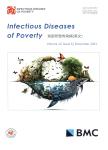Why is malaria associated with poverty? Findings from a cohort study in rural Uganda
作者机构:Department of Disease ControlLondon School of Hygiene&Tropical MedicineLondonUK Big Data InstituteNuffield Department of MedicineUniversity of OxfordOxfordUK Infectious Diseases Research CollaborationKampalaUganda Department of Clinical ResearchLondon School of Hygiene and Tropical MedicineLondonUK School of MedicineMakerere University College of Health SciencesKampalaUganda MRC Tropical Epidemiology GroupLondon School of Hygiene and Tropical MedicineLondonUK Department of EconomicsSOASUniversity of LondonLondonUK Department of MedicineUniversity of CaliforniaSan FranciscoUSA School of Biological and Biomedical SciencesDurham UniversityDurhamUK
出 版 物:《Infectious Diseases of Poverty》 (贫困所致传染病(英文))
年 卷 期:2016年第5卷第1期
页 面:715-725页
核心收录:
学科分类:1004[医学-公共卫生与预防医学(可授医学、理学学位)] 1002[医学-临床医学] 1001[医学-基础医学(可授医学、理学学位)] 100201[医学-内科学(含:心血管病、血液病、呼吸系病、消化系病、内分泌与代谢病、肾病、风湿病、传染病)] 10[医学]
基 金:supported by the Leverhulme Centre for Integrative Research in Agriculture and Health US National Institures of Health(U19AI089674) Research and Policy for Infectious Disease Dynamics(RAPIDD)program of the Science and Technology Directorate,US Department of Homeland Security,the Fogarty International Center(US National Institutes of Health) the Bill&Melinda Gates Foundation(OPP1053338)
主 题:Malaria Socioeconomic Poverty Development Housing Wealth index Uganda
摘 要:Background:Malaria control and sustainable development are linked,but implementation of‘multisectoral’intervention is restricted by a limited understanding of the causal pathways between poverty and *** investigated the relationships between socioeconomic position(SEP),potential determinants of SEP,and malaria in Nagongera,rural ***:Socioeconomic information was collected for 318 children aged six months to 10 years living in 100 households,who were followed for up to 36 *** density was recorded using monthly light trap *** prevalence was measured routinely every three months and malaria incidence determined by passive case ***,we evaluated the association between success in smallholder agriculture(the primary livelihood source)and ***,we explored socioeconomic risk factors for human biting rate(HBR),parasite prevalence and incidence of clinical malaria,and spatial clustering of socioeconomic ***,we investigated the role of selected factors in mediating the association between SEP and ***:Relative agricultural success was associated with higher *** turn,high SEP was associated with lower HBR(highest versus lowest wealth index tertile:Incidence Rate Ratio 0.71,95%confidence intervals(CI)0.54–0.93,P=0.01)and lower odds of malaria infection in children(highest versus lowest wealth index tertile:adjusted Odds Ratio 0.52,95%CI 0.35–0.78,P=0.001),but SEP was not associated with clinical malaria *** analysis suggested that part of the total effect of SEP on malaria infection risk was explained by house type(24.9%,95%CI 15.8–58.6%)and food security(18.6%,95%CI 11.6–48.3%);however,the assumptions of the mediation analysis may not have been fully ***:Housing improvements and agricultural development interventions to reduce poverty merit further investigation as multisectoral interventions against *** interdisplinary research is needed to understa



